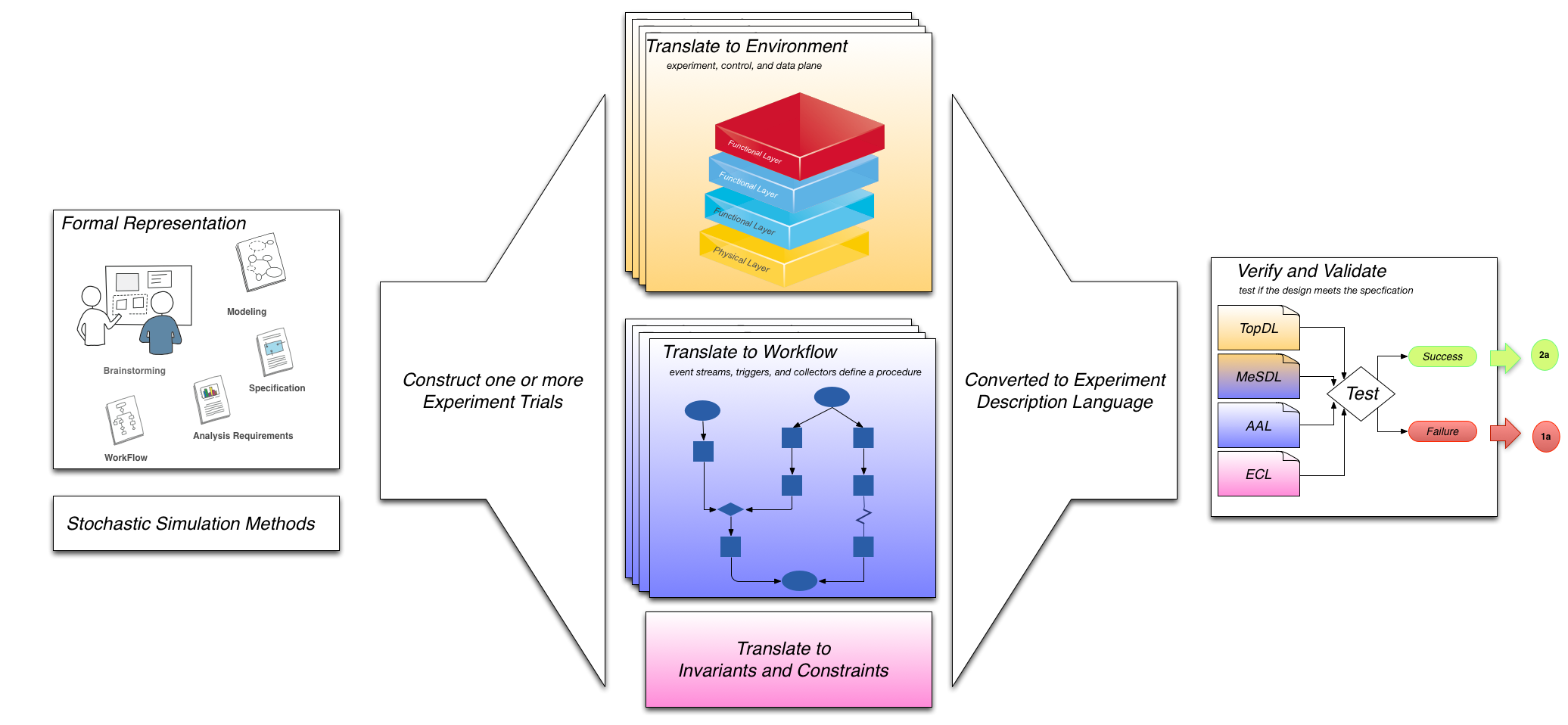
DETERLab is regarded as a scientific instrument to create knowledge and understanding through observation and measurement of cyber security technologies. DETERLab provides a flexible software framework to structure the experiment environment and execute the procedue while ensuring experiment validity and repeatability. In this section we discuss each of these aspects in detail.
The experiment environment defines the set of resources required to configure a DETERLab experiment. It consists of the three planes and elements with different functional behaviors mapped onto them. We discuss each in detail below.
The experiment environment consists of three planes:
The plane that carries the experiment traffic. It consists of the set of experiment nodes, substrates, and their topological structure. The functional behaviors are mapped onto the experiment nodes. For example, an experiment may consist of background traffic generators including webserver and webclients, attack traffic generators, including botmasters and bots. The structure is defined in the TopDL/ns-2 description file.
The plane to send and receive control specific instructions and signalling commands to the experiment nodes. In addition to the experiment nodes, other control-specific nodes such as an orchestrator and a bridge may also belong to the control plane. The topological structure of the control plane is defined by the testbed or configured per experiment in the TopDL/MesDL description file. The topology consists of four types of elements. Namely, directors, bridges, overlays, and orchestrators.
The plane to carry measurement specific traffic for for analysis and visualization. In addition to the experiment nodes, other data specific nodes, such as aggregators and collectors, may also belong to the data plane. The topological structure of the data plane is defined by the testbed or configured per experiment in the description TopDL/MesDL file. The topology consists of four types of elements, namely, sensors, collector, aggregators and queriers.
There are five types of properties that can be configured for each experiment element:
The property characterizes the computational capacity of the element. A functional mapping of the behavior onto the element can impose requirement constraints, that is, a webserver requires at least 200Mhz of computational capacity. Computational capacity units can be specified in jiffies and clock speed.
This property characterizes the local persistent (and non--persistent) recording capacity of the element. A functional mapping of the behavior onto the element can impose different storage requirement constraints. For example, a router element in the experiment may not require any storage, whereas, a collector element may require a lot of storage capacity.
This property characterizes the cardinality and type of network interface on the experiment element. There may be more than one interface. Each interface has its own rate and delay characteristics. The functional mappings of the behavior onto the element can impose different interface requirements. For example, collectors may require a high bandwidth interface, core routers in an experiment topology may require many interfaces.
This property characterizes the types of stimulus the element can sense. For example, all network traffic, CPU load, heat.
This property characterizes the types of responses the element can implement. For example, bring down an interface, increase delay on a link, partition a network
Each experiment element has incoming and outgoing connections to one or more experiment planes.
The experiment workflow defines the dynamic procedure enacted to conduct a DETERLab experiment. It consists of three main activities:
An event is a signal to invoke a particular behavior on the experiment nodes. The event streams in an experiment are partially ordered set of events defined as a directed acyclic graph. An experiment workflow consists on one or more event streams defined in an AAL description file. All event signals are sent over the control plane typically by the orchestrator.
A synchronization point in the dynamic experiment workflow. The trigger may be time-based, that is the orchestrator waits for a particular amount of time to lapse or event-based, where the orchestrator waits to receive a signal before proceeding with the workflow. Triggers can be used to synchronize one or more event streams. All triggers are sent over the control plane. Triggers are defined as part of the experiment workflow in the AAL description file.
A signal to enable sensing and collection of experiment measurements for feedback as triggers and for analysis. All sensing and collection measurements are sent over the data plane. Collectors may be defined within the procedure description AAL file.
The experiment validity is maintained by a set of constraints and invariants asserted throughout the experiment lifecycle. They relate to the experiment environment and the workflow as follows:
During the process of defining and configuring the environment, the constraints and invariants can be used to ensure the validity of a particular configuration step. Some constraints and invariants may indicate key capacity requirements for validity, for example, CPU requirements for experiment nodes, while some may be functional requirements, such as, number of available client hosts. The constraints and invariants are defined in an ECL description file and processed by the DETERLab validity management framework.
During experiment execution, the constraints and invariants can be used to ensure that the experiment proceeds in accordance with these assumptions. The constraints can thus be used to ensure safety, that is, the experiment will not do anything bad and liveness that is, the experiment will do something useful. The constraints and invariants are defined in an ECL description file and processed by the DETERLab validity management framework.